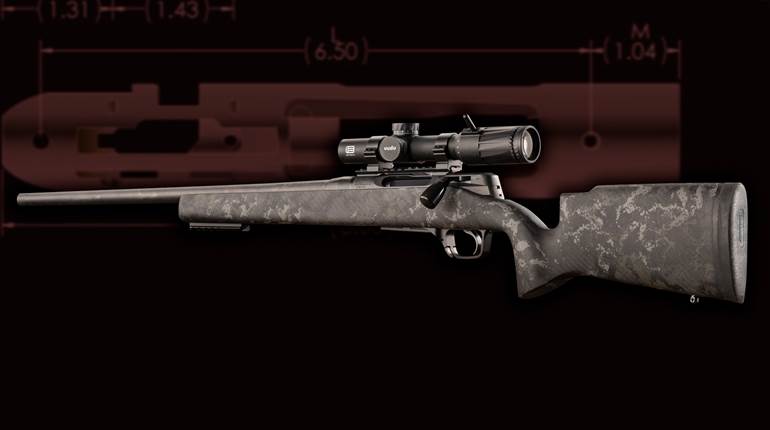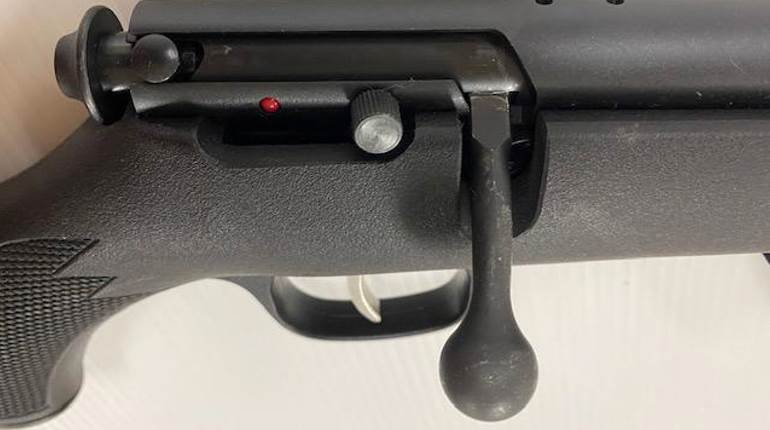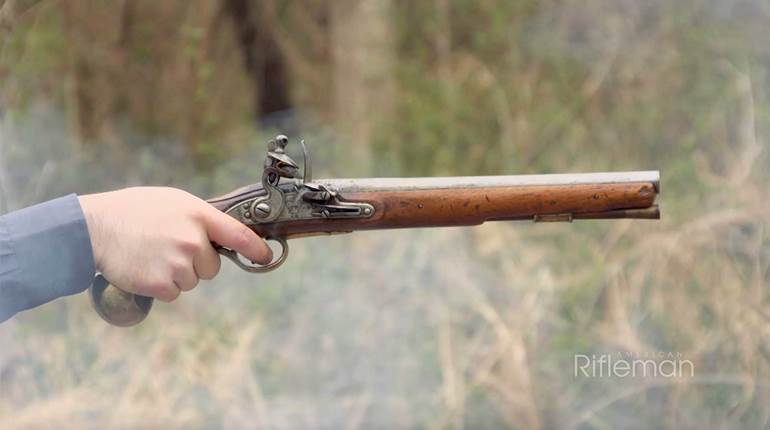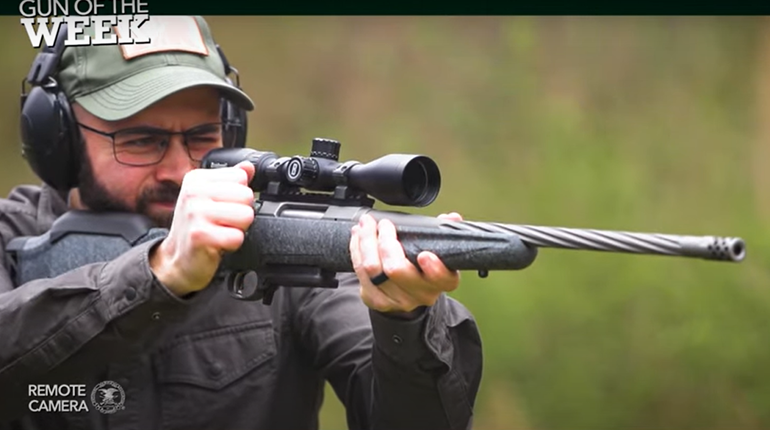
When it comes to rifles, most people might ask, “What’s the big deal, really, whether it’s a left-hand action or a right-hand action? Can’t a lefty learn to run the more common platform?” Well, yes, but let’s take my family as an example. Both my parents are right-handed, and my sister and I are left-handed. All of dad’s guns had right-hand actions, and I dealt with it. Now, fast-forward a generation. My wife, Donna, is also left-handed (maybe that’s what I liked about her), but her son and both my daughters are all right-handed.
So, what are our kids going to do with our left-hand guns? Or, to put it another way, have you (in your smug right-handedness) ever tried to sell a left-handed gun? The actual percentage of left-handed people is unclear. Ten percent is often quoted, but let’s add in left-eye-dominant folks who shoot right-handed because that’s the way they were taught and right-handed folks with right-eye issues and … well, the real number isn’t important. Most folks are right-handed, a minority are left-handed, and the difference doesn’t seem to follow direct genetic lines. At every convention, I meet right-handed folks who are dealing with the best choices for their left-handed kids or partners, and vice-versa, and universally friendly, bilateral options do exist for these people.
A Word About Safety
There are two reasons why left-handed people should shoot left-hand firearms, and right-handed people should shoot right-hand firearms … or why both should shoot genuinely bilateral firearms. One is ease of operation, but it’s important that we not overlook that there is also a genuine safety issue. Most repeating actions eject on the right side. By design, this is the weaker side of the action: In the case of a catastrophic failure, vented gas is directed away from the shooter—it has to go somewhere. Typically, some will go down through the magazine well and much will go out through the ejection port. Guess what? If you’re left-handed and shooting a right-hand action, the super-heated gas and shrapnel will be directed straight toward your face.
It’s true that case heads don’t rupture very often, but, as “Dirty Harry” Callahan said, “Do you feel lucky, punk?” I think it’s rare for righties to shoot lefty actions, so I’ll keep it personal: Every time a lefty fires a cartridge in a right-hand action, he or she is banking on luck. A dentist friend of mine, a fellow lefty, had a whole room full of firearms—mostly right-hand ones because, like me and most lefties, that’s what he grew up using. I asked him how his dental practice would be if he lost his right eye, and he subsequently switched to left-hand actions. Good move.
Truly bilateral actions also solve that problem. “Almost-bilateral” actions, universal in operation but ejecting on the right (or left) side do not. We lefties spend much of our shooting lives dancing on the edge, and we’re fortunate that catastrophic failures don’t happen very often, but it’s important to understand that true left-hand, mirror-image actions are the safest for lefties. So are true bilateral actions (which are fairly uncommon). Almost-bilateral actions are not as safe for lefties, but they can be easier to use. If you’re a parent who has kids using wrong-hand actions (including almost-bilateral), make sure they wear eye protection. We all should anyway, under all circumstances, but I suspect relatively few of us actually wear shooting glasses all the time, especially in the field.

Handguns
The safety aspect applies primarily to long guns. Virtually all semi-automatic pistols eject to the right, but being held at arm’s length, this is rarely an issue. Ease of operation for lefties varies. Bilateral safeties are not possible on all semi-automatics but are a blessing when present, and many don’t have manual safeties at all. Bilateral slide releases used to be rare, but we lefties learned to deal with it, and now, due to military solicitations for pistols, most major makers offer them on certain models. The situation is similar for right-hand magazine releases—at least in this case the release can often be disassembled and reassembled in the opposite configuration.
Double-action revolvers are universal in firing, but cylinder cranes swing to the left, so that a right-handed person can keep the gun in the shooting hand while reloading. A lefty must switch the revolver to the right hand for ejection and reloading. Depending on where the release lever is located, one could say that older break-open double-actions are more bilateral than current designs. Single-action revolvers typically have the loading port on the right side. This is the weak spot in the frame, so placement on the right is a design safety feature for right-handed shooters—but it actually makes left-handed operation easier.

As with long guns, break-open handguns, such as T/C’s Contender, are among the most bilateral designs, but bolt-action “specialty handguns” are also worthy of consideration. In a bolt-action handgun, a right-hand bolt is perfect for a left-handed shooter because it can then be operated with the supporting (right) hand. And while such pistols are heavy, and are often chambered for powerful cartridges, they are customarily fired from steady rests, so, with an opposite bolt, you can maintain your position and grip with your shooting hand when working the bolt with your supporting hand.
Long Guns
Both rifles and shotguns create bigger challenges because they are intended for two-handed operation, and, from a safety standpoint, the shooter’s face is closer to the action. For wrong-handed use, the bolt-action is the worst. In fact, it’s impossible for a lefty to work a right-hand bolt gun the way it was intended, maintaining its position on the shoulder. From most shooting positions, lefties must typically take the rifle partway down, then roll it a bit left with the supporting hand and at the same time reach over the top to work the bolt with the shooting hand. The only other way is to work the bolt with the supporting hand, which is faster, but only practical when the rifle is firmly rested.
Experienced shooters can become very fast at operating wrong-hand bolts, but we look like contortionists. Bolt-actions are pretty much one way or the other, right or left, but they are not the only roadblock for ambidextrous operation. Most thumbhole stocks are designed exclusively for either right-handed or left-handed use. They are difficult to use wrong-handed, and usually impossible to use correctly from the opposite side. Rollover cheekpieces are another nightmare; they not only preclude a proper cheek weld on the wrong side, but, with a bit of recoil, pose a risk of slicing a wrong-hander’s jaw.
In shotgun stocks, a wee bit of cast can help make a perfect fit, but cast goes one way or the other. It’s a real mess for a lefty to shoot a shotgun cast for a right-handed shooter. For proper ambidextrous use, a shotgun stock needs to be dead straight.
Safeties are kind of a grab bag. Sliding-tang safeties, such as on the Ruger No. 1, Mossberg’s Model 500 series and most side-by-side and over-under shotguns, are probably the easiest to use ambidextrously. The same is true of tang-mounted cocking levers as used on the Blaser, Krieghoff and Sauer. Among the worst for wrong-handed use are button safeties in trigger guards. Common in slide-action and semi-automatic shotguns, they are difficult for a lefty to operate: The shooting hand must come off the pistol grip and reach under the action to manipulate the safety—a bad delay when a pheasant is flushing from under your feet. Fortunately, some of these can be reversed for left-handed operation. Many safeties require some creative placement of the hand or thumb. Most ARs, and all military M16-series rifles, for instance, have a safety lever only on the left side intended for operation with the right thumb. When in a “contact imminent” mode, I simply kept my left thumb on the left side of the receiver near the safety, not a real problem. Luckily, as with pistols, a growing number of AR-style rifles are now designed for nearly seamless ambidextrous manipulation of the controls.

Almost Bilateral
The bolt-action is a special case; most of the other action types are “almost bilateral.” By that I mean operation is neutral; the “almost” comes from their right-side ejection. Again, this is a safety issue best mitigated by religious use of shooting glasses. Chances of a problem are remote—but it only has to happen once!
Aside from placement/operation of the safety, right-ejecting slide-actions and semi-automatics are ambidextrous in operation, and in both rifles and shotguns true mirror-image, left-hand models are rare. Although I try to stick with left-hand or true bilateral actions, one of my weaknesses is the great old Winchester Model 12 slide-action. It’s simple to reverse the safety, but you can’t do anything about the right-hand ejection. So, I can tell you from experience (tens of thousands of rounds) that shooting glasses are a really good idea—I have no idea how many times I’ve gotten gunpowder in my right eye.
The ejecting case itself is rarely a problem; it usually goes to the side or forward. There is one notable exception: With typical AR-style rifles, the empties often go right down a lefty’s shirt collar—and they come out of the chamber hot enough to momentarily burn the skin. In military service, left-handed recruits quickly learn to button their shirts all the way to the top!
Lever-actions are often touted as bilateral options, but that isn’t really true with most modern designs. Excepting the “Original Henry,” all modern Henry lever-actions are side-eject. The same is true of all current Marlins, Browning BLRs and long-gone greats such as the Savage 99 and Winchester 88. These are “almost bilateral.” Current (and recent) Winchester 94s and Mossberg 464s are “angle-eject” rifles, allowing low scope mounting over the receiver. In order to accomplish that, the right receiver wall is lower than the left. I guess you could call these “almost, but not quite, bilateral.” The Mossberg 464 and new-production Winchester 94s have a tang safety that, as I’ve said, is the most ambidextrous-friendly type. Henry rifles and the Browning BLR use hammer safeties without a manual safety; current Marlins have a push-button hammer block safety at the rear of the receiver.
True Bilateral
Yep, you’re right; that doesn’t leave us with many truly bilateral rifles and shotguns, not only with equal ease of operation from either shoulder, but also with absolutely equal safety. In the lever-action world, only the good old top-eject guns qualify. The obvious problem with them is that they defy conventional scope mounting above the receiver. Now that I’m having increasing trouble resolving iron sights, I lean heavily toward side-eject and angle-eject “almost bilateral” actions that accommodate scopes. But in the strictest sense, only top-eject guns such as the older Winchesters, including original 1895s and their modern Browning/Winchester reproductions, and the original Henry properly qualify. Among pump-actions, John Browning’s 1915 patent is an absolutely bilateral bottom-eject design. Originally manufactured by Remington as its Model 17, the design morphed into the classic Ithaca Model 37—which remains in production today. Browning’s excellent BPS is also a bottom-eject gun based on the John Browning design. These are the only “true bilateral” slide-actions.
Now, that leaves us with single-shots and double barrels, both side-by-side and over-under, in both rifles and shotguns. Falling-block single-shots—such as the Browning 1885, Dakota Model 10 and Ruger No. 1—are pretty much as bilateral as you can get, and don’t forget T/C’s under-lever-operated Contender and Encore. I have a major soft spot for single-shot rifles; I’ve always considered the Ruger No. 1 to be the best-looking factory rifle ever made, but maybe I like them because they’re so equal-opportunity. While falling-blocks have little hedge against a catastrophic failure (regardless of which side you’re shooting from) they are among the strongest of all actions: That massive breechblock isn’t going anywhere. That one shot has the advantage of making you a bit more careful, but also the inherent disadvantage of being the only cartridge onboard, and the rifle is either fully loaded or completely unloaded as a result.
Whether rifle or shotgun, top-lever-operated break-open guns (single-shot, side-by-side, over-under, or, for that matter, a three-barrel drilling) are also pretty much bilateral with equal opportunity, especially those fitted with the almost-universal tang safety. However, here’s an odd nuance. The standard (and also almost universal) left-to-right opening lever is intended for right-handed operation. In the old days, left-hand doubles, if requested, were made with opposite levers that opened right-to-left. Right now, Rigby has a Rising Bite Double Rifle in .470 NE under construction that’s a true left-hand gun, with “left-hand” opening lever and reversed trigger order. I doubt if such a true left-hand double has been made for decades.

Here’s the deal: Using a standard, left-to-right top lever, a right-handed person can put the side or ball of the thumb on the lever and use the entire hand as leverage for opening. A left-hander pushes the lever with the tip of the thumb. I’ve never found this to be inconvenient, and, honestly, since I’ve used left-to-right levers for 50 years I don’t know if I could switch—but, technically, break-open guns aren’t “100 percent bilateral.”
Remember my comment on that new left-hand Rigby having a reversed trigger order? Although two-trigger over-unders are unusual, normally the front trigger fires the bottom barrel and the rear trigger fires the top barrel. This is so the more in-line recoil of the bottom barrel comes first. In side-by-sides, the front trigger is usually for the right barrel and the rear trigger fires the left barrel. Since the triggers can’t be directly aligned, the front trigger is usually on the right; the back trigger just to its left. That is actually a right-handed arrangement. With the rear trigger slightly left, a right-hander is less likely to inadvertently engage it during recoil from the first barrel, but a lefty is more likely. This doesn’t happen much with shotguns, but it’s a common (and unforgettable) error with heavy-recoiling double rifles. Thus, a proper left-hand side-by-side would have the front trigger fire the left barrel, followed by the rear trigger for the right barrel. My Krieghoff double .500 NE with a left-hand stock is actually set up this way, but all of my other two-trigger side-by-sides have the more common right-handed arrangement. The only possible “true bilateral” arrangement would be a single trigger, most common in shotguns but less so in double rifles.
Single triggers are okay on shotguns, but with double rifles I prefer double triggers because, on dangerous game, I can put an expanding bullet in one barrel and a solid in the other. The standard right-hand trigger arrangement doesn’t bother me because, fortunately, I don’t have that inadvertent “doubling” malady. It can afflict anyone, right or left-handed, so if you’re a lefty and you have it, it may be possible for a double-gun mechanic to reverse the trigger order. Honestly, that may or may not help. The standard cure—which will work—is to shoot the rear trigger first. This is not “proper” double-gun shooting because it requires more hand movement, but it beats getting kicked into next week!





































